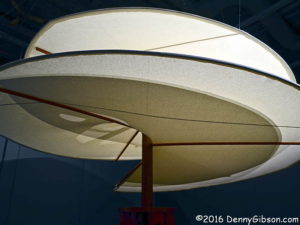 A new exhibit opened at the Cincinnati Museum Center just over a week ago. Da Vinci — The Genius opened on Friday the 20th and I was there on Monday. It’s a dandy. The exhibit is billed as having “17 themed galleries” and I’m sure that’s true. Another simpler — though not entirely accurate — view is that’s its the “Mona Lisa” and everything else. I say that because the “Mona Lisa” display is quite large and is different from the others. It is the last area reached in the exhibition and the last discussed here.
A new exhibit opened at the Cincinnati Museum Center just over a week ago. Da Vinci — The Genius opened on Friday the 20th and I was there on Monday. It’s a dandy. The exhibit is billed as having “17 themed galleries” and I’m sure that’s true. Another simpler — though not entirely accurate — view is that’s its the “Mona Lisa” and everything else. I say that because the “Mona Lisa” display is quite large and is different from the others. It is the last area reached in the exhibition and the last discussed here.
The bulk of the exhibit consists of modern implementations of devices envisioned by da Vinci some five centuries ago. Using his drawings and descriptions and utilizing materials available when the the ideas were committed to paper, more than 70 of da Vinci’s concepts have been brought to life. Most are full size.
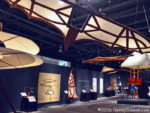
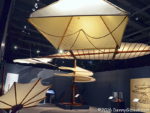 Devices related to flight appear early in the exhibit. The photo at the top of this article is of the helicopter-like Vite Aerea. In addition to wings, screws, and propellers targeting actual flight, da Vinci sketched out mechanisms intended to test ideas or measure natural forces. Almost all of his “flying machines” were impractical because of weight or other issues. A partial exception is the “parachute” seen in the foreground of the second picture. In 2000, British daredevil Adrian Nichols stepped out of a hot air balloon with a ‘chute built to da Vinci’s specifications. Jumping from 10,000 feet, Nichols rode the 500 year old design to within 2,000 feet of the surface before turning to something more modern. Freeing himself from the pyramid shaped device and deploying something more up to date was not because of any failure of the device to do its job but to prevent being injured by the heavy wood frame on landing.
Devices related to flight appear early in the exhibit. The photo at the top of this article is of the helicopter-like Vite Aerea. In addition to wings, screws, and propellers targeting actual flight, da Vinci sketched out mechanisms intended to test ideas or measure natural forces. Almost all of his “flying machines” were impractical because of weight or other issues. A partial exception is the “parachute” seen in the foreground of the second picture. In 2000, British daredevil Adrian Nichols stepped out of a hot air balloon with a ‘chute built to da Vinci’s specifications. Jumping from 10,000 feet, Nichols rode the 500 year old design to within 2,000 feet of the surface before turning to something more modern. Freeing himself from the pyramid shaped device and deploying something more up to date was not because of any failure of the device to do its job but to prevent being injured by the heavy wood frame on landing.
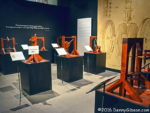
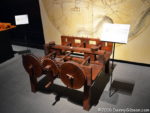
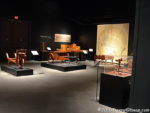 Leonardo’s earth bound inventions were more viable. The second picture is of a machine used to cut threads on a shaft. The third picture shows an area that breaks from the normal “hands off” museum policy. Here attendees are encouraged to touch and operate the mechanisms to better understand the principles involved and to better appreciate da Vinci’s genius. Da Vinci didn’t invent the “Out of Order” sign but it can be useful in his world. On the day of my visit the Ingranaggio a Lanterna don’t work cause the vandals took the handle.
Leonardo’s earth bound inventions were more viable. The second picture is of a machine used to cut threads on a shaft. The third picture shows an area that breaks from the normal “hands off” museum policy. Here attendees are encouraged to touch and operate the mechanisms to better understand the principles involved and to better appreciate da Vinci’s genius. Da Vinci didn’t invent the “Out of Order” sign but it can be useful in his world. On the day of my visit the Ingranaggio a Lanterna don’t work cause the vandals took the handle.
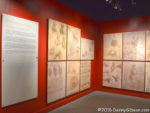
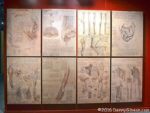
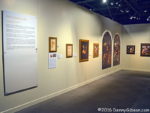 Enlarged examples of da Vinci’s anatomy studies are displayed as are reproductions of several other drawings and paintings. His “Last Supper” is the subject of a video. The anatomical drawings demonstrate da Vinci’s talent but are also evidence of his boundless curiosity. It’s obviously good to have a healthy supply of both but I find myself thinking that curiosity without talent is to be preferred over talent without curiosity.
Enlarged examples of da Vinci’s anatomy studies are displayed as are reproductions of several other drawings and paintings. His “Last Supper” is the subject of a video. The anatomical drawings demonstrate da Vinci’s talent but are also evidence of his boundless curiosity. It’s obviously good to have a healthy supply of both but I find myself thinking that curiosity without talent is to be preferred over talent without curiosity.
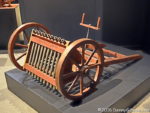
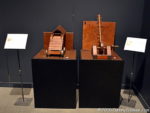
 A sad truth is that concocting dreadful machines of war was frequently da Vinci’s “day job”. That’s not to say that it was entirely unpleasant to him. He had an interest in the science and art of war at an early age but he often obtained patronage for his artistic endeavors by promising the means to destroy enemies. He certainly wasn’t the last artist/scientist to find that the case.
A sad truth is that concocting dreadful machines of war was frequently da Vinci’s “day job”. That’s not to say that it was entirely unpleasant to him. He had an interest in the science and art of war at an early age but he often obtained patronage for his artistic endeavors by promising the means to destroy enemies. He certainly wasn’t the last artist/scientist to find that the case.
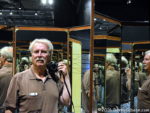 Of his Stanza Degli Specchi, an eight-sided mirrored room, da Vinci said that someone in it “will be able to see every part (of himself) endless times”. There are, of course, parts of me that you are better off not seeing even once but this from-the-shoulder shot is alright.
Of his Stanza Degli Specchi, an eight-sided mirrored room, da Vinci said that someone in it “will be able to see every part (of himself) endless times”. There are, of course, parts of me that you are better off not seeing even once but this from-the-shoulder shot is alright.

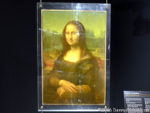
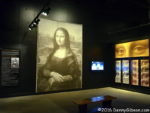 In 2004, researcher Pascal Cotte was given unparalleled access to the original “Mona Lisa”. The painting was removed from its frame and photographed multiple times with a purpose-built ultra-high-resolution multispectral camera. Analysis of the captured data has resulted in things like an understanding of the original colors and a possible explanation for the apparent absence of eyebrows and lashes. The data was also used to produce a full-sized replica of the original. That’s it in the second picture. That’s also it in the third picture in a true “dark side of the moon” rear view. The two large portraits on the far wall relate to Cotte’s most controversial claim. Cotte believes that four fairly distinct layers can be identified in the painting and that one is an almost finished picture of a completely different woman than the one visible on the surface. On the right is a recreation of that other portrait. Everyone agrees the the painting changed during the many years da Vinci worked on it. Some authorities, however, believe all changes were along the lines of constant tweaking. They are not ready to accept that substantially completed layers were overlaid with other entire layers.
In 2004, researcher Pascal Cotte was given unparalleled access to the original “Mona Lisa”. The painting was removed from its frame and photographed multiple times with a purpose-built ultra-high-resolution multispectral camera. Analysis of the captured data has resulted in things like an understanding of the original colors and a possible explanation for the apparent absence of eyebrows and lashes. The data was also used to produce a full-sized replica of the original. That’s it in the second picture. That’s also it in the third picture in a true “dark side of the moon” rear view. The two large portraits on the far wall relate to Cotte’s most controversial claim. Cotte believes that four fairly distinct layers can be identified in the painting and that one is an almost finished picture of a completely different woman than the one visible on the surface. On the right is a recreation of that other portrait. Everyone agrees the the painting changed during the many years da Vinci worked on it. Some authorities, however, believe all changes were along the lines of constant tweaking. They are not ready to accept that substantially completed layers were overlaid with other entire layers.
 Leonardo da Vinci is believed to have spent about fourteen years on the “Mona Lisa” and he still wasn’t entirely done with it when he died. You can use your mobile phone and a chair, frame, and background provided by the museum to complete your own in a fraction of a second. Bring your own Lisa.
Leonardo da Vinci is believed to have spent about fourteen years on the “Mona Lisa” and he still wasn’t entirely done with it when he died. You can use your mobile phone and a chair, frame, and background provided by the museum to complete your own in a fraction of a second. Bring your own Lisa.
Da Vinci — The Genius runs until September 25. Major restoration work will close much of the Museum Center on July 1. The Children’s Museum and the da Vinci exhibit space are in the basement and will remain open. Entry will continue to be through the main doors of Union Terminal.

Pingback: Leo da Vinci and the Forty Machines | Denny G's Road Trips Blog